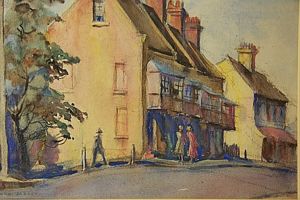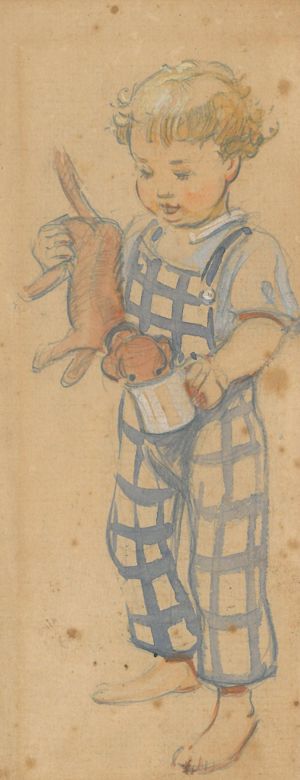Contents |
Biography
Dora Jarret was a Sydney artist and illustrator who studied in Paris in the 1920s. The State Library of NSW notes that Dora was the first woman artist to exhibit solo in Brisbane.
Dora was a contemporary of well-known Australian women artists Grace Cossington Smith and Alison Rehfisch.
Dora married late in life and did not have any children.
The NSW Art Gallery holds two of her works, 'Quimper' (purchased 1929) and 'Holy Trinity Church, Berrima' (purchased 1948). See http://www.artgallery.nsw.gov.au/collection/works/?q=Dora+Jarret
The State Library of NSW contains a watercolour of Dora's, 'Pitt Street', (circa 1935). See http://acms.sl.nsw.gov.au/item/itemdetailpaged.aspx?itemid=1038152
The National Gallery of Australia, Canberra, also holds a work of Dora's.
The Design and Art Australia Organisation website provides detailed biographical information about Dora. See http://www.daao.org.au/bio/dora-jarret/personal_details/? for a summary of Dora's life and work.
See below for a detailed account of her artistic career up to the 1950s, written by Joan Kerr in 1996. http://www.daao.org.au/bio/dora-jarret/biography/?
DORA JARRET
Painter, teacher, illustrator, graphic artist and cartoonist, was born in Sydney of French ancestry.
She studied in Paris under Andre L’hôte and at Colarossi’s. According to Power (p.47, apparently quoting Margaret Coen but without acknowledgement), Dora was 'pretty, petite, very proud of her French ancestry and recently returned from Paris’ when a student of Dattilo Rubbo's in the late 1920s.
She shared a studio in a condemned building owned by the Electricity Commission near Circular Quay with fellow students, the lovers Alison Rehfisch and George Duncan , and was the only member of their set to have travelled overseas. (George Duncan was a New Zealander, but that of course didn’t count.) Jarret’s 'Awful results of sketching on a roof', an undated gentle caricature of a woman sketching from and subsequently falling off a roof with her sketchbook, pencils and chair preceding her, was apparently a joke about her friend Grace Cossington Smith’s plein air painting habits. Found as a loose sheet inside Cossington Smith’s sketchbook no.5 (NGA), it seems likely to have been drawn in Sydney when both were studying with Rubbo.
In the 1920s Jarret exhibited with the Royal Art Society, had work in the Australian Art Society’s first exhibition (1927) and was a regular exhibitor with the Australian Watercolour Institute. With Rehfisch, Neville Barker and Arthur Murch, she exhibited as 'Four Young Artists’ at Farmer’s Blaxland Galleries in 1929. She showed watercolours, travel sketches and linocuts; the AGNSW purchased An Italian Bypath . The Bulletin (3 December 1929) noted:
Dora Jarret, looking like a rose adorned with pearls instead of dewdrops, was a radiant spot on the balcony at the Blaxland Galleries last week. Chum Alison Rehfisch looked smart as paint, which was all to the good, as the two young creatures were welcoming the world to a show of their canvases. Neville Barker and Arthur Murch, who are also exhibiting, added male support and nice manners to the gathering (quoted Power, 47-48).
On the closing night of the exhibition the artists held a party in Alison and Dora’s new studio at 8 Bridge Street, which was apparently attended by the NSW Governor’s wife Lady de Chair (see Sunday Sun 15 December 1929, cited by Power, p.49). A weekly sketch club had its headquarters at 8 Bridge Street; Elaine Haxton was one of the younger members until she went overseas in 1931: 'We paid half a crown for a model and a cuppa tea’ (Haxton, 'A Reminiscence’ in Alison Rehfish and George Duncan catalogue 1976, quoted Power, p.49. SEE also Meg Stewart, Reminiscence of My Mother ). George still officially lived at Tempe, but actually inhabited the place too. E.A. Harvey (unpub. Mss) recalled that they 'shared a big studio in Bridge Street and went everywhere in a baby Austin. George was as big as the other two put together; the car was Jarret’s (Jar Ray as everyone calls her), and she drove, consequently the car had a perpetual lean’. A photograph of Alison and Dora painting beside a car in 1932 is included in Power (p.52), alongside one of the three of them in the Blue Mountains (apparently Katoomba lookout). The three of them beside the car near Cooma in 1933 is on p.53.
Alison and George moved in together to 12 Bridge Street, the site of more notoriously licentious parties, e.g. a 'loincloth party’ held in honour of Christopher Brennan, which Jarret attended dressed as a Pierrot [sic] with frilled collar (described Power, p.49). The 'Prehistoric and Primitive Party’, held in 1933 in honour of George who was leaving 'Sordid Sydney for Peppy Paris’, included Dora and Alison, wearing grass skirts, welcoming guests into 'the jungle’ decorated with friends’ 'island treasures’ and with 'tribal drawings’ on the walls. The colourful send-off included Norman Lindsay’s hornpipe act and a dancing exhibition by Ellen Gray with a male partner from the German School of Dancing where she took lessons (Power, p.53). It was this party that inspired Norman Lindsay’s watercolour The Party (1933, p.c.), with its bare-breasted woman dancer in the centre (called Coen but clearly Gray and her male partner) and reputedly including Jarret, in grass skirt and bra, seated on the floor on the right (reproduced Power, p.48). Norman sent a photograph of the painting to Rehfisch with the note: 'To Alison – with thanks for the best of all possible parties’. After George went to Europe and Alison followed with her friend Ellen Gray in 1933, Norman Lindsay took over the studio, moving down from Springwood at a time of personal and artistic crisis so he could devote himself to oil painting. When Lindsay left, Margaret Coen, Douglas Stewart and their daughter Meg took it over (Power, p.57). Jarret remained in Sydney; in 1936 she passed on the news that George had three paintings hung at the RA, two 'on the line’, to the Daily Telegraph (Power, p.77). Alison alone returned to Sydney in 1939 and, following Rehfisch’s death, a party was held at Dora Jarret’s studio that included Alison’s daughter Peg, B.J. Waterhouse, President of the AGNSW board of trustees, and various artists (Power, p.81). A photograph taken after the 'Show of Fives’ at Macquarie Galleries c.1940 (Power, p.97) includes Jarret between Jean Bellette and Rehfisch along with other artists including 'George Duncan just back from London’.
Germaine states that Jarret mainly painted landscapes, old houses and portraits in oil and watercolour. She also illustrated Henry Handel Richardson’s The Bath , published in 1933, with elegant drawings of four pubescent girls in various stages of undress, and she designed bookplates (Mark Ferson). Germaine claims that her first solo show was at Brisbane in 1929, but this must be an error. She was, however, a member of the Royal Queensland Art Society in 1946. In 1951 she was included in a small group exhibition in the foyer of a J.C. Williamson theatre in Melbourne with Elsa Russell and Piers Bourke (cited Paula Furby). When Sydney Rubbo interviewed some of his father’s former students (tape recording n.d but after Rubbo’s death, AGNSW, mentioned Power 35), Jarret was living in Neutral Bay (Cossington Smith was at Turramurra, Janna Bruce was at Warrawee and Alison Rehfisch was at Pymble).
Sources
1. More than forty references to Dora Jarret in Australian newspapers can be found at http://trove.nla.gov.au/result?q=%22dora%20jarret%22
2. A digital version of 'the Bath', Dora's 1933 collaboration with Henry Handel Richardson, is available online through the State Library of Victoria.
3. Information on Dora's life and work is contained in the following publications:
■McCulloch, Alan McCulloch, Susan McCulloch, Emily McCulloch-Childs. The New McCulloch's Encyclopedia of Australian Art. 4th Edition, Aus Art Melbourne & The Miegunyah Press, 2006. Page 550 ■Germaine, Max. Artists and Galleries of Australia, Volumes 1 & 2, Third Edition. Craftsman Press, Sydney, 1990. Page 343 ■Germaine, Max. A Dictionary of Women Artists of Australia. Craftsman House, Sydney, 1991. Page 226 ■Campbell, Jean. Australian Watercolour Painters: 1780 to the Present Day. Craftsman House, Sydney, 1989. Page 328
Source: Australian Art Sales Digest website: http://www.aasd.com.au/subscribers/artist_details.cfm?concat=JarrettDora
Footnotes
Acknowledgments
Thank you to Adam Muyt for creating Jarret-26 on 15 Jul 13. Click the Changes tab for the details on contributions by Adam and others.
No known carriers of Dora's ancestors' DNA have taken a DNA test.
Have you taken a DNA test? If so, login to add it. If not, see our friends at Ancestry DNA.
Rejected matches › Dora Unknown (1895-1985)
Featured National Park champion connections: Dora is 23 degrees from Theodore Roosevelt, 20 degrees from Stephanus Johannes Paulus Kruger, 21 degrees from George Catlin, 24 degrees from Marjory Douglas, 32 degrees from Sueko Embrey, 20 degrees from George Grinnell, 24 degrees from Anton Kröller, 23 degrees from Stephen Mather, 21 degrees from Kara McKean, 24 degrees from John Muir, 20 degrees from Victoria Hanover and 32 degrees from Charles Young on our single family tree. Login to find your connection.




